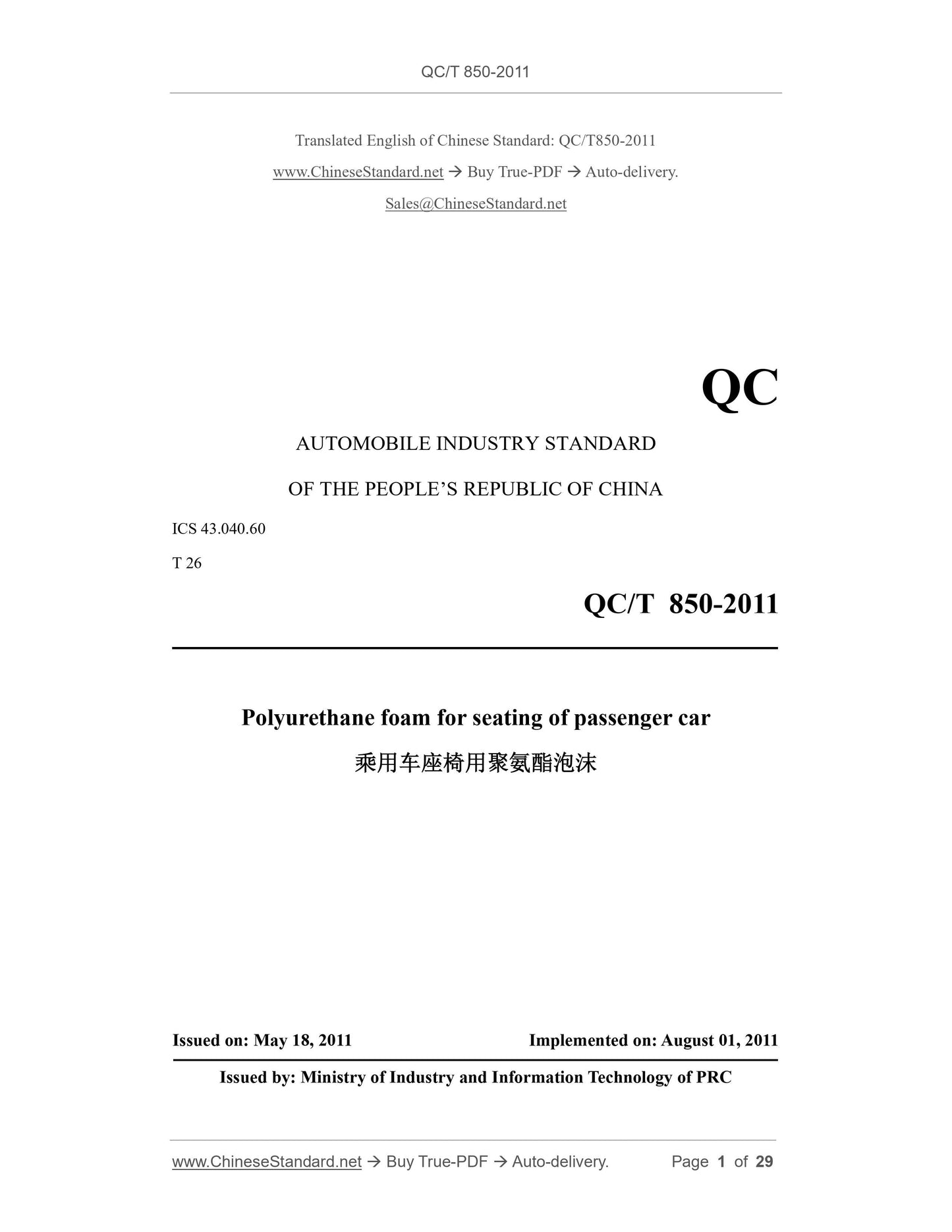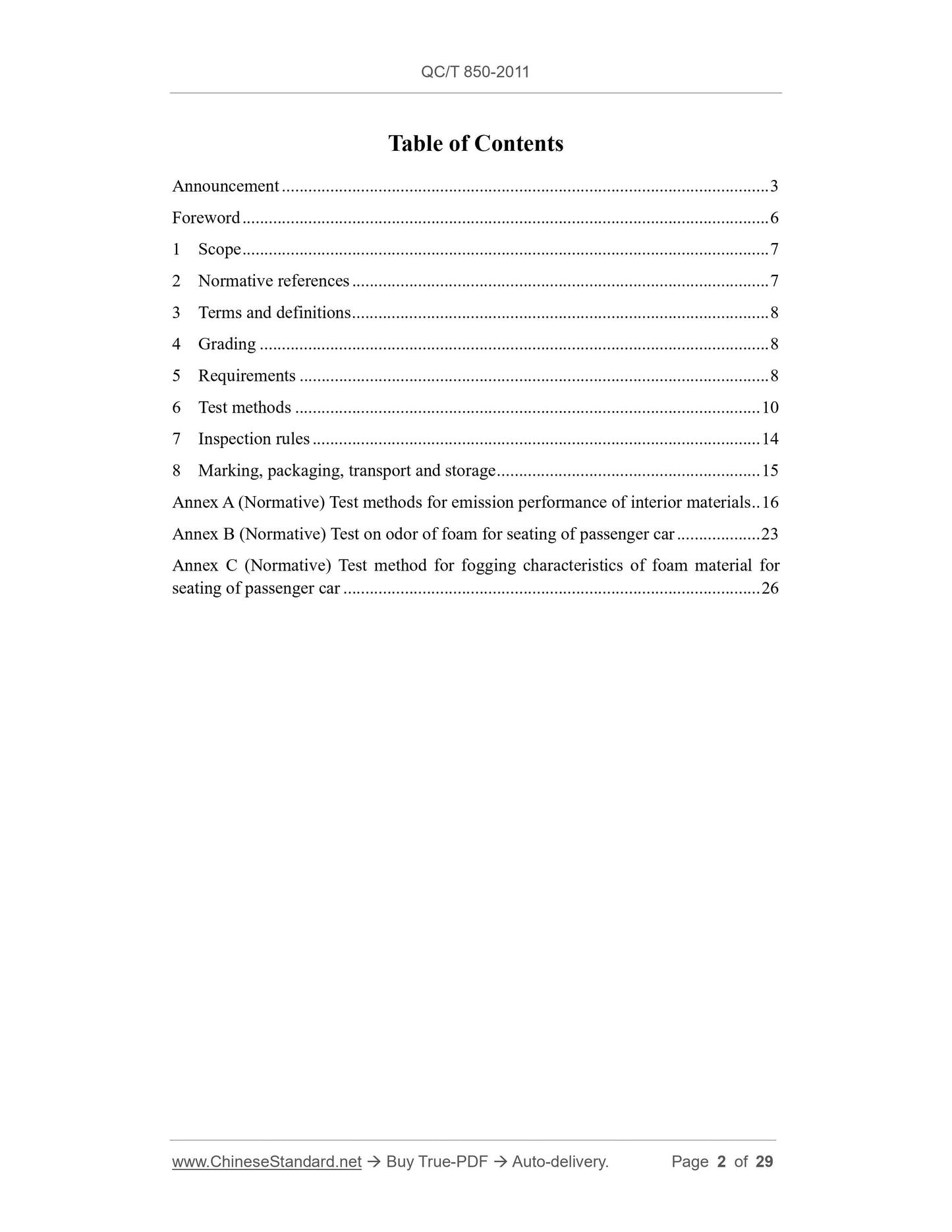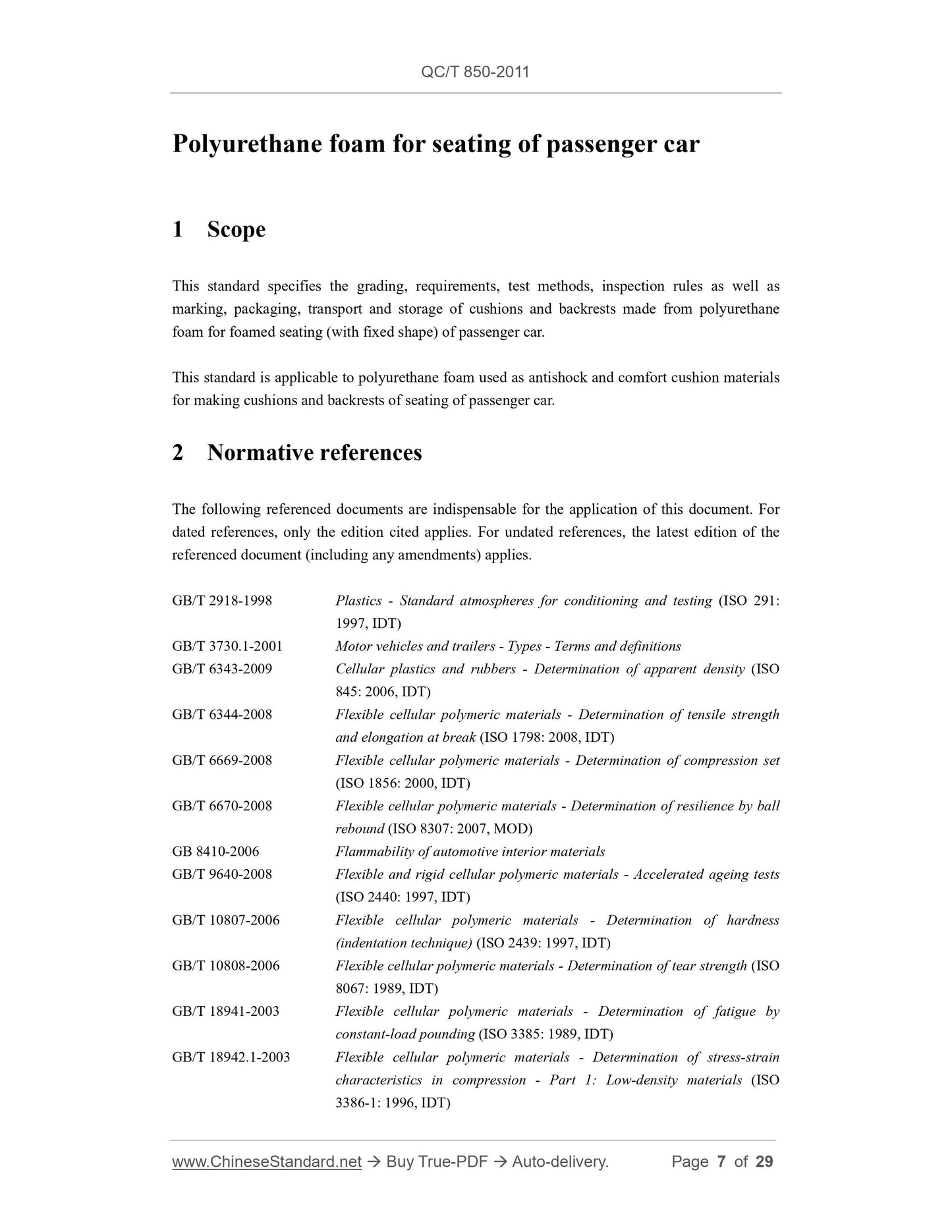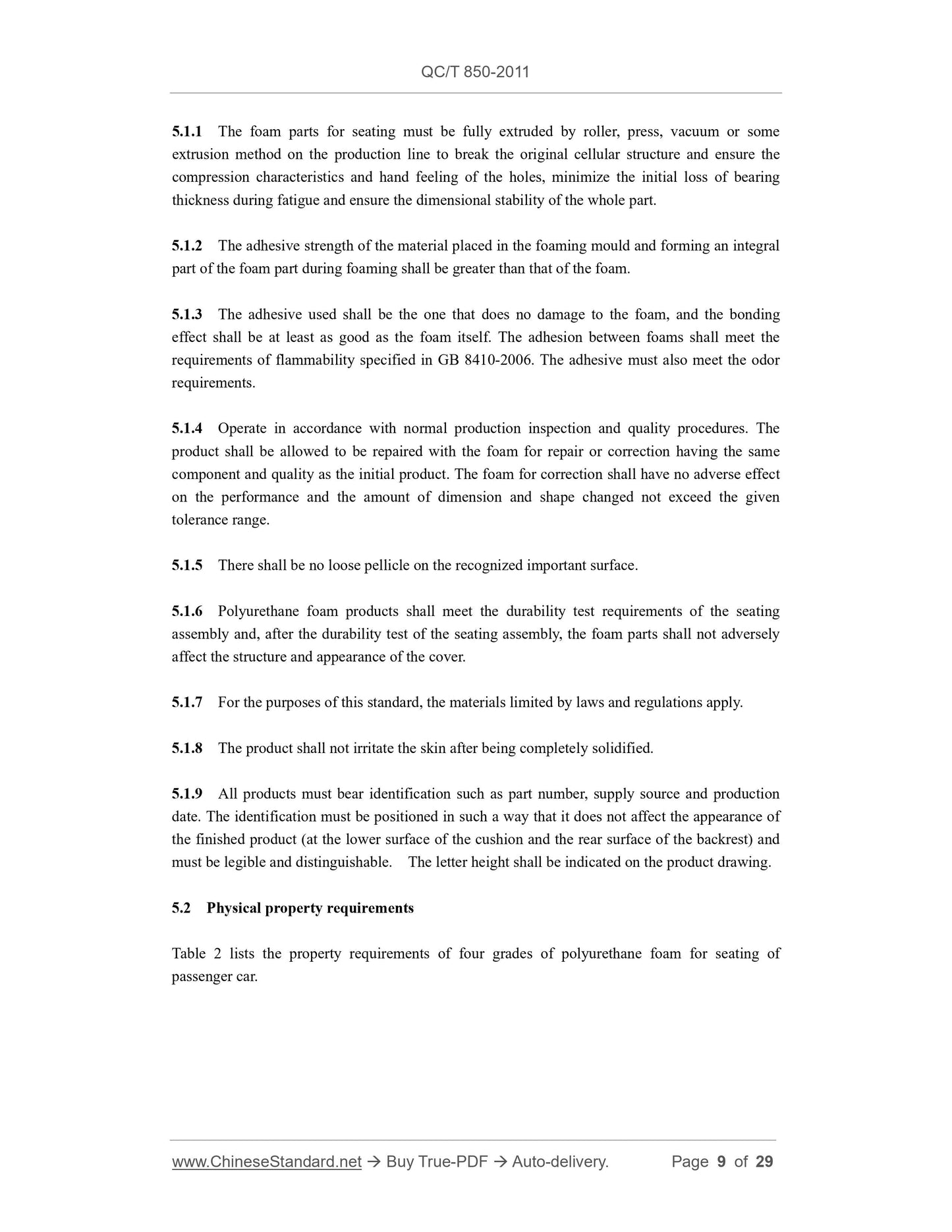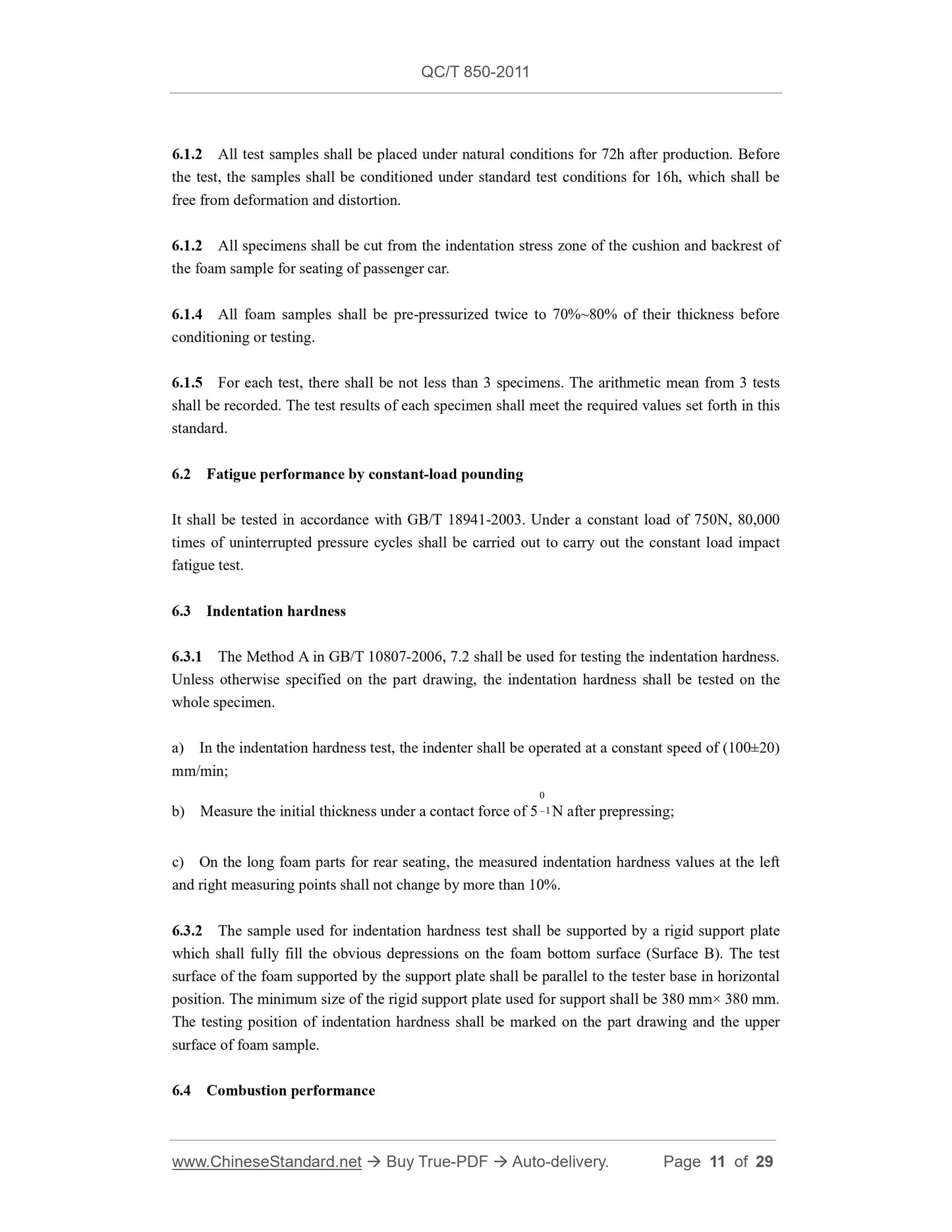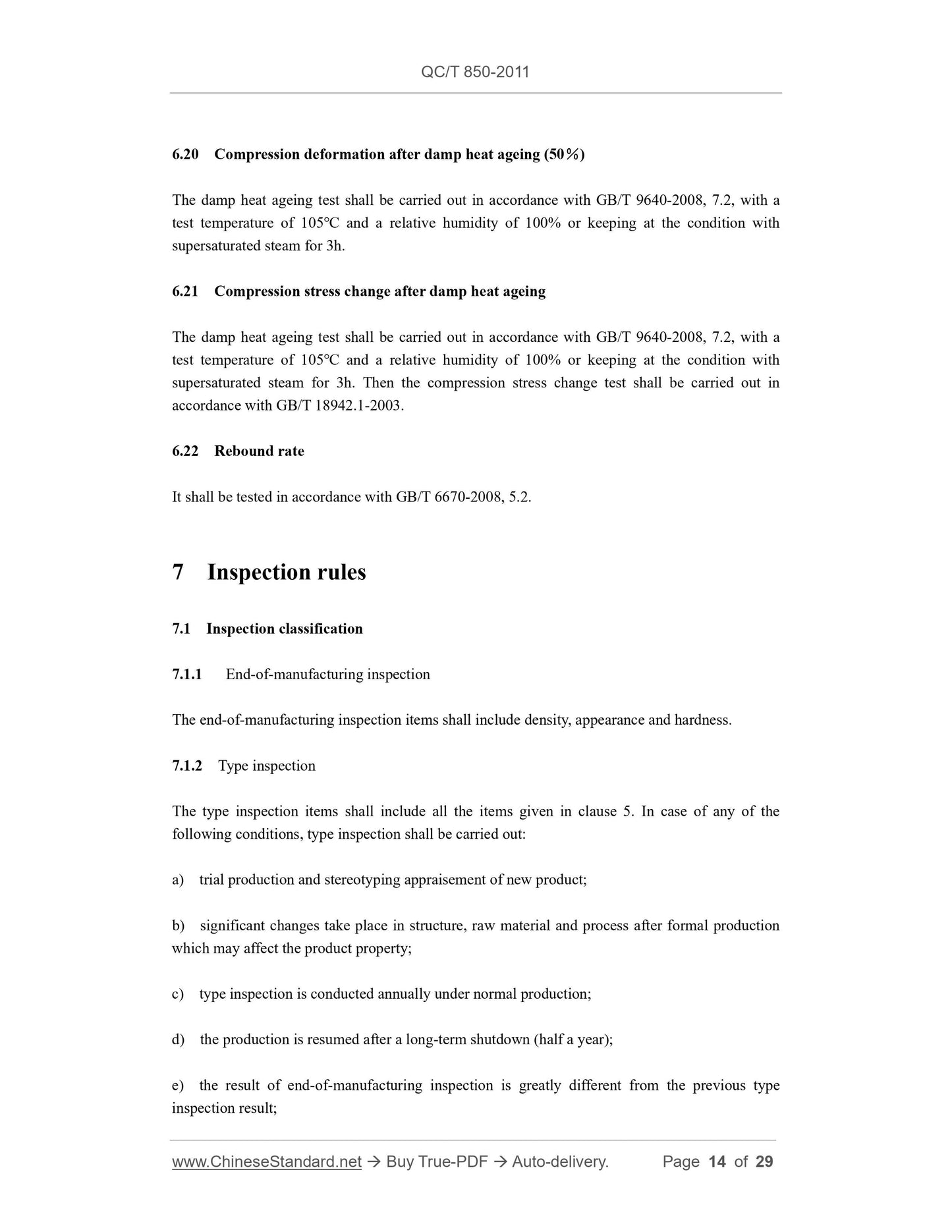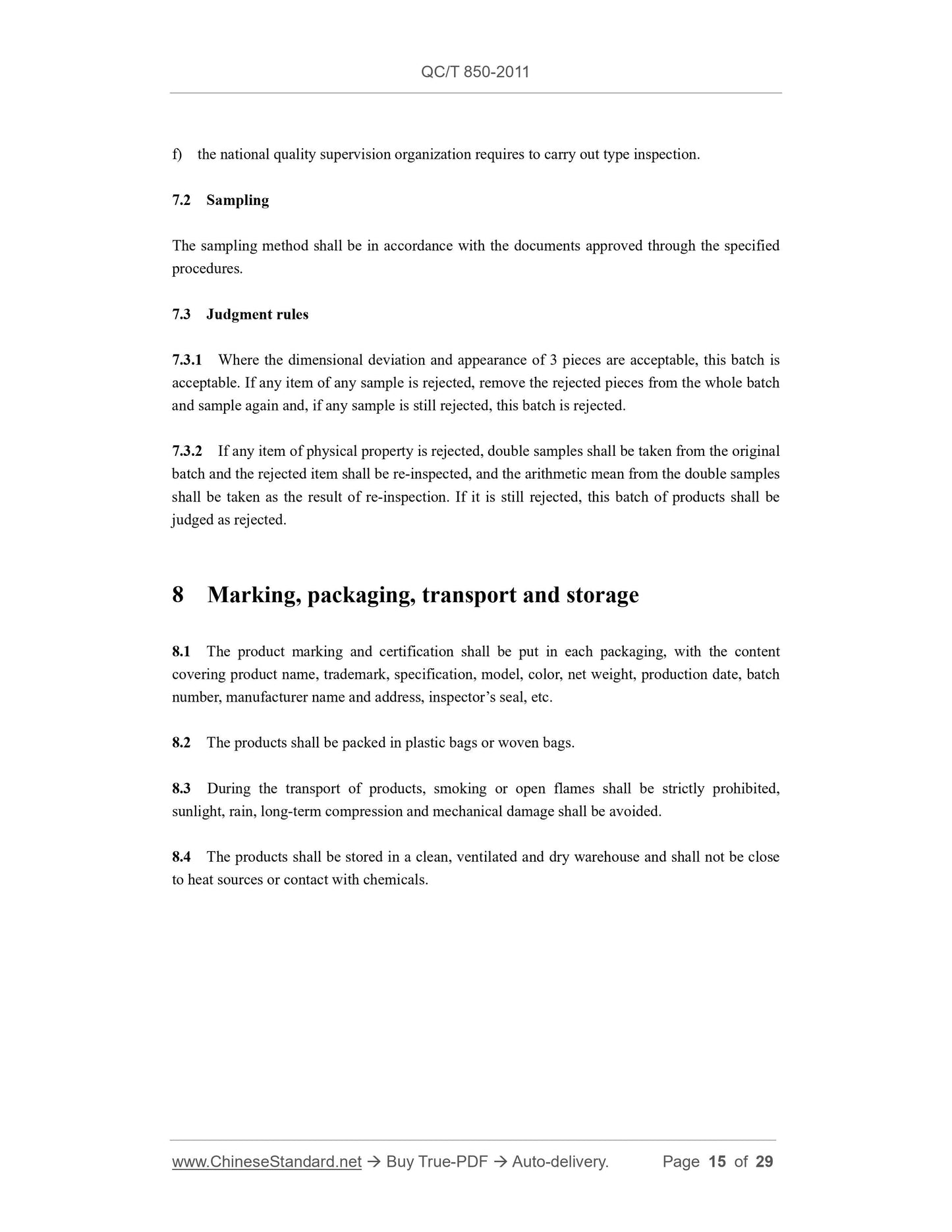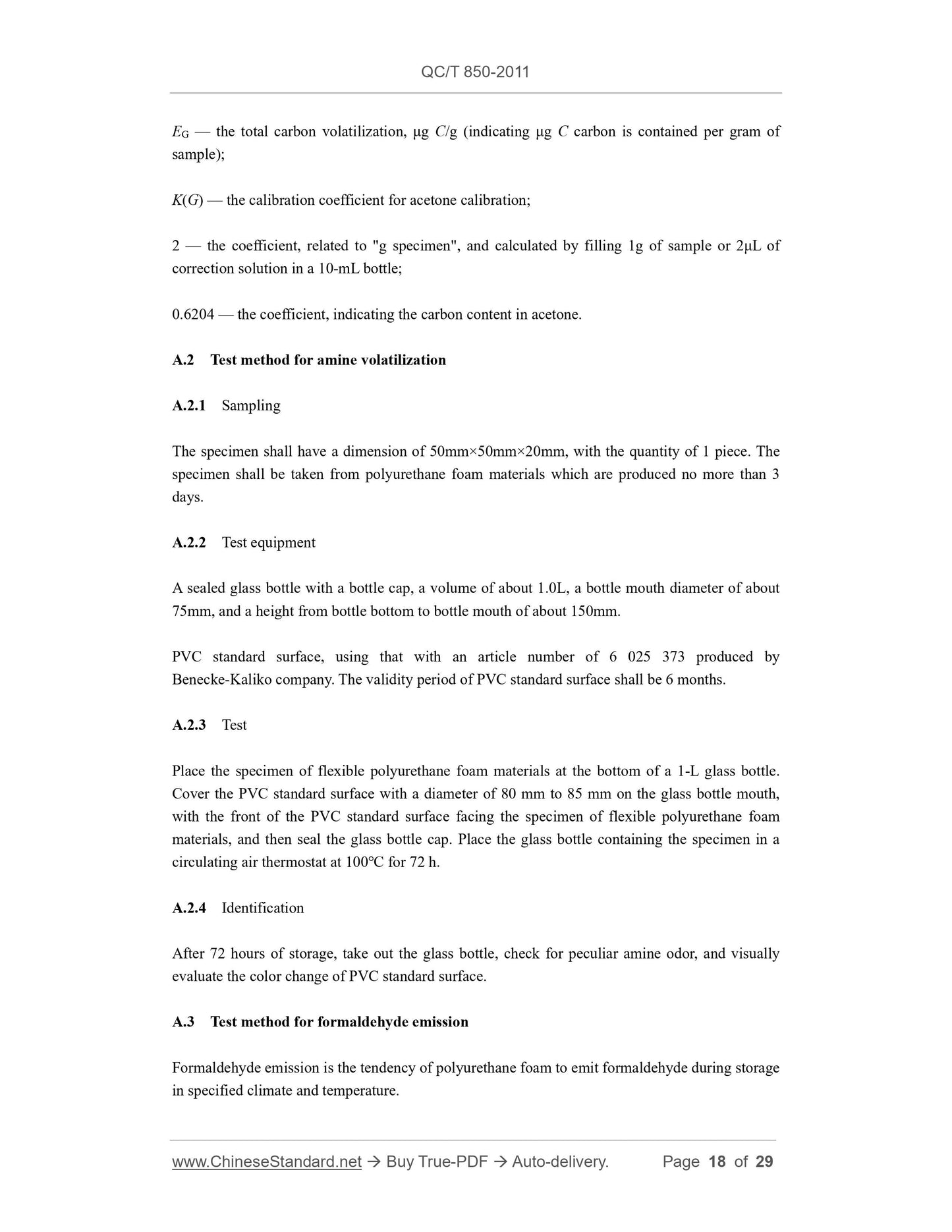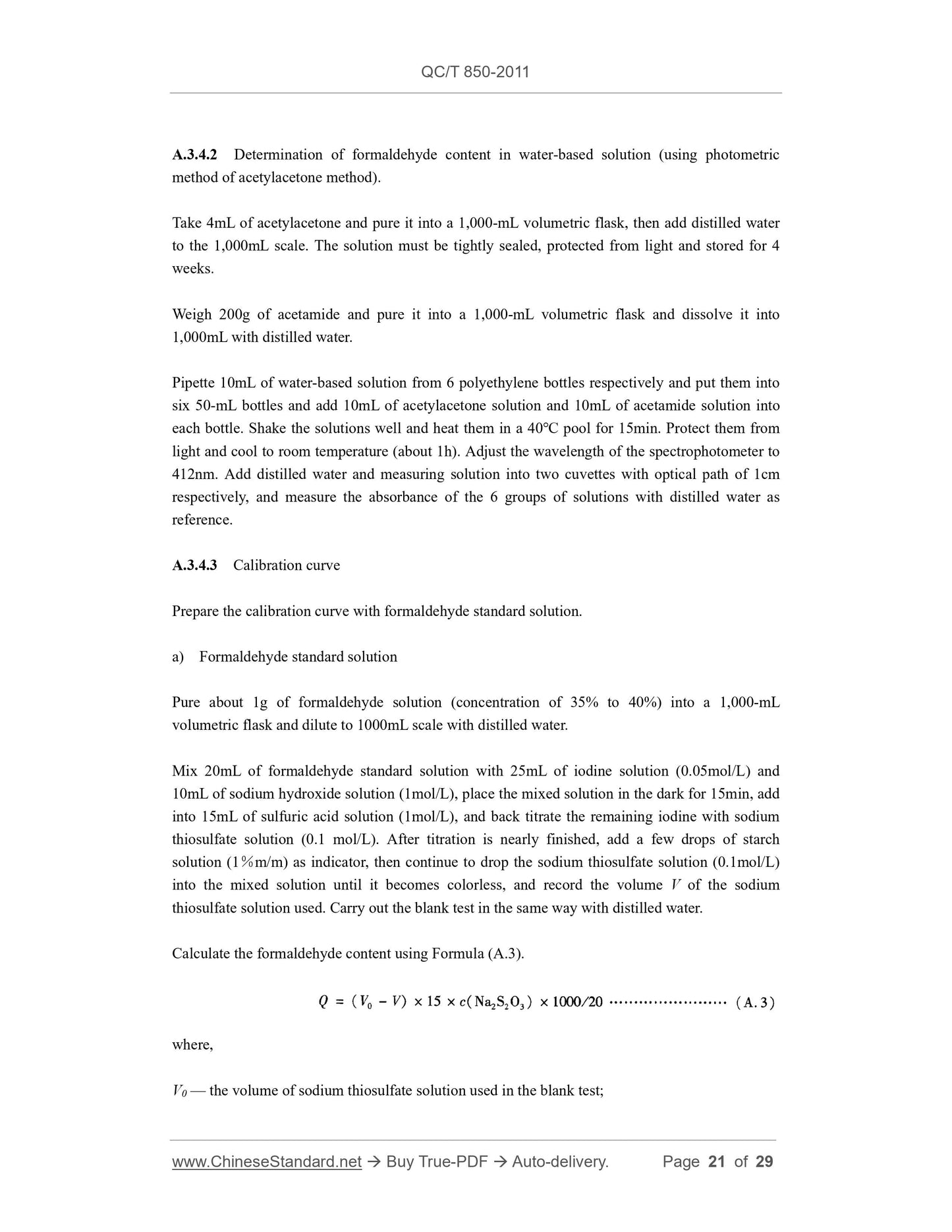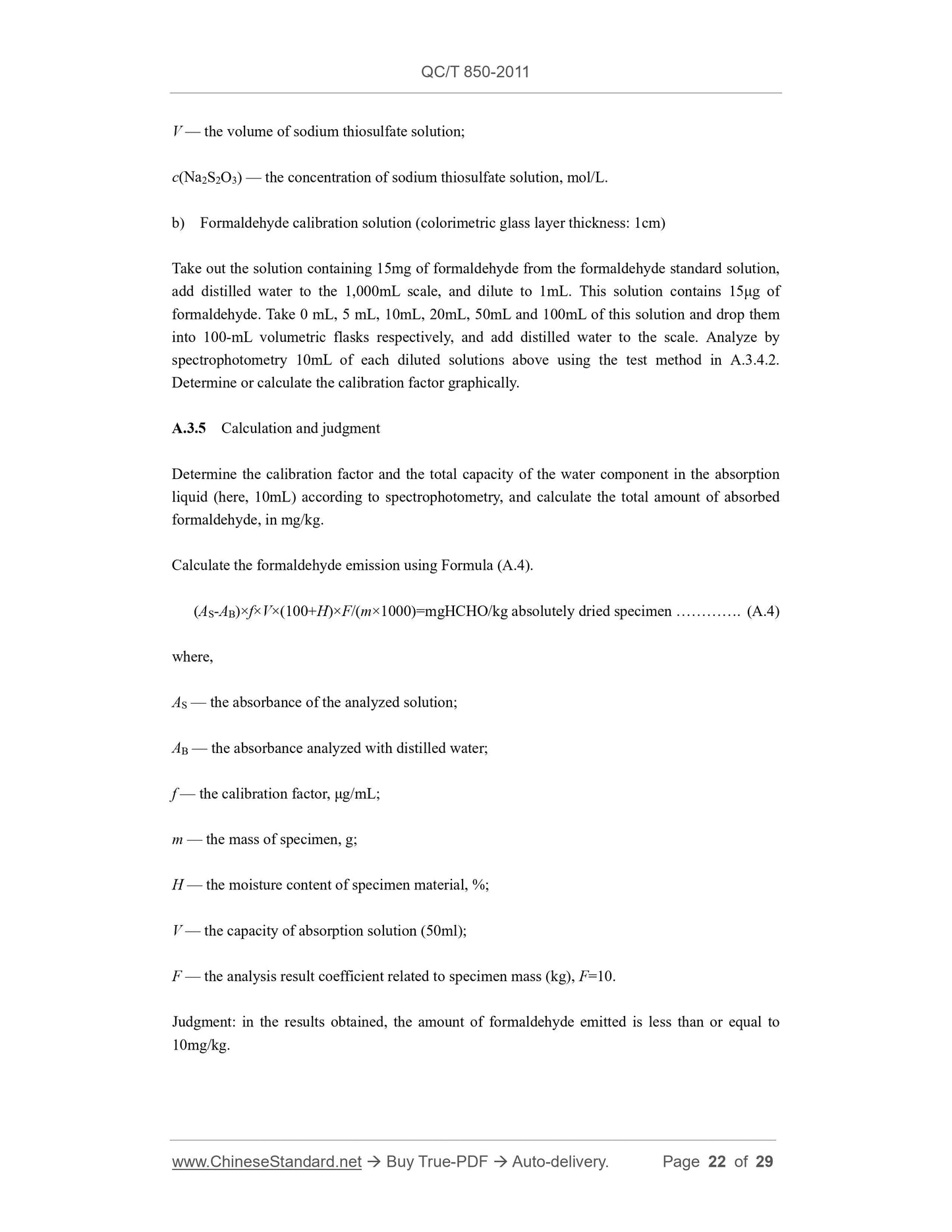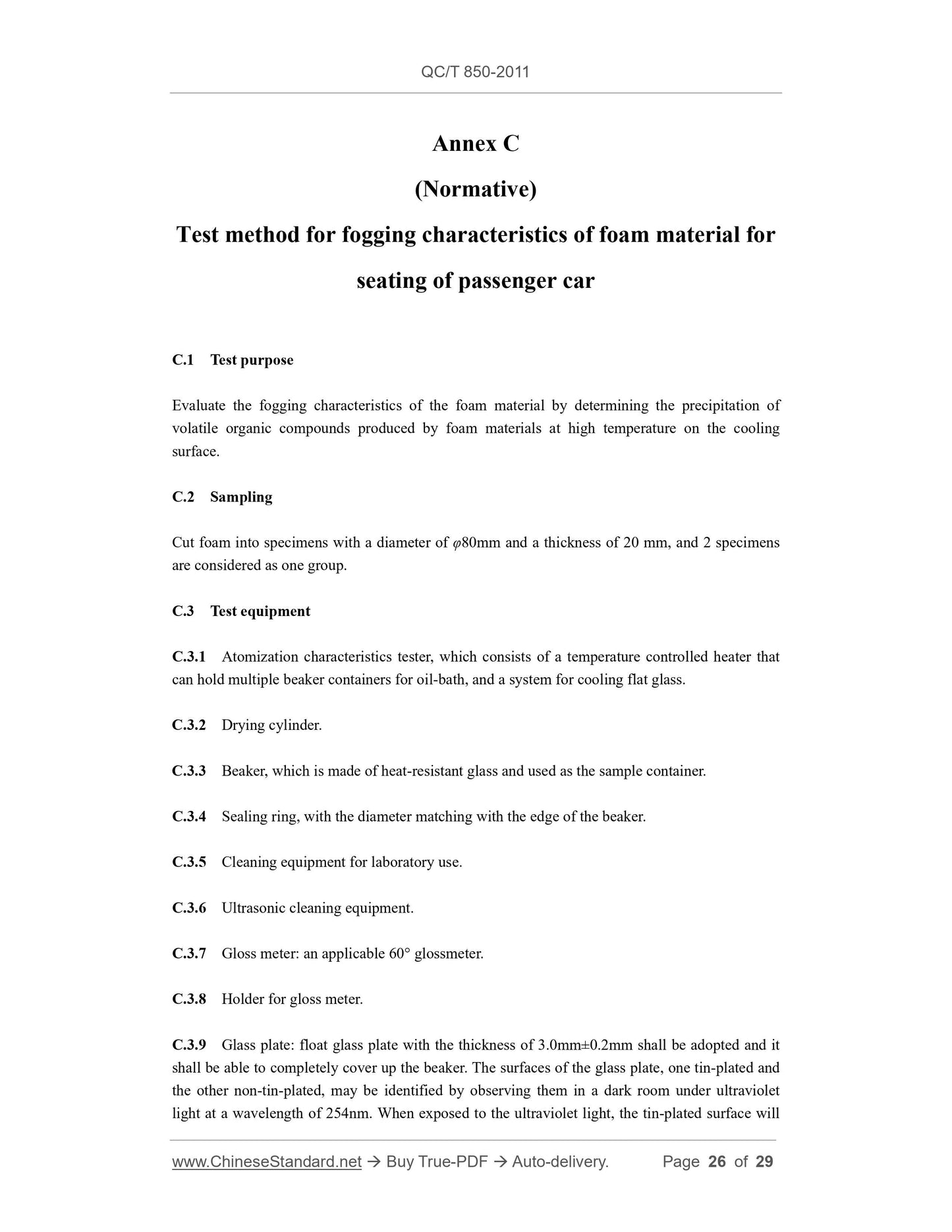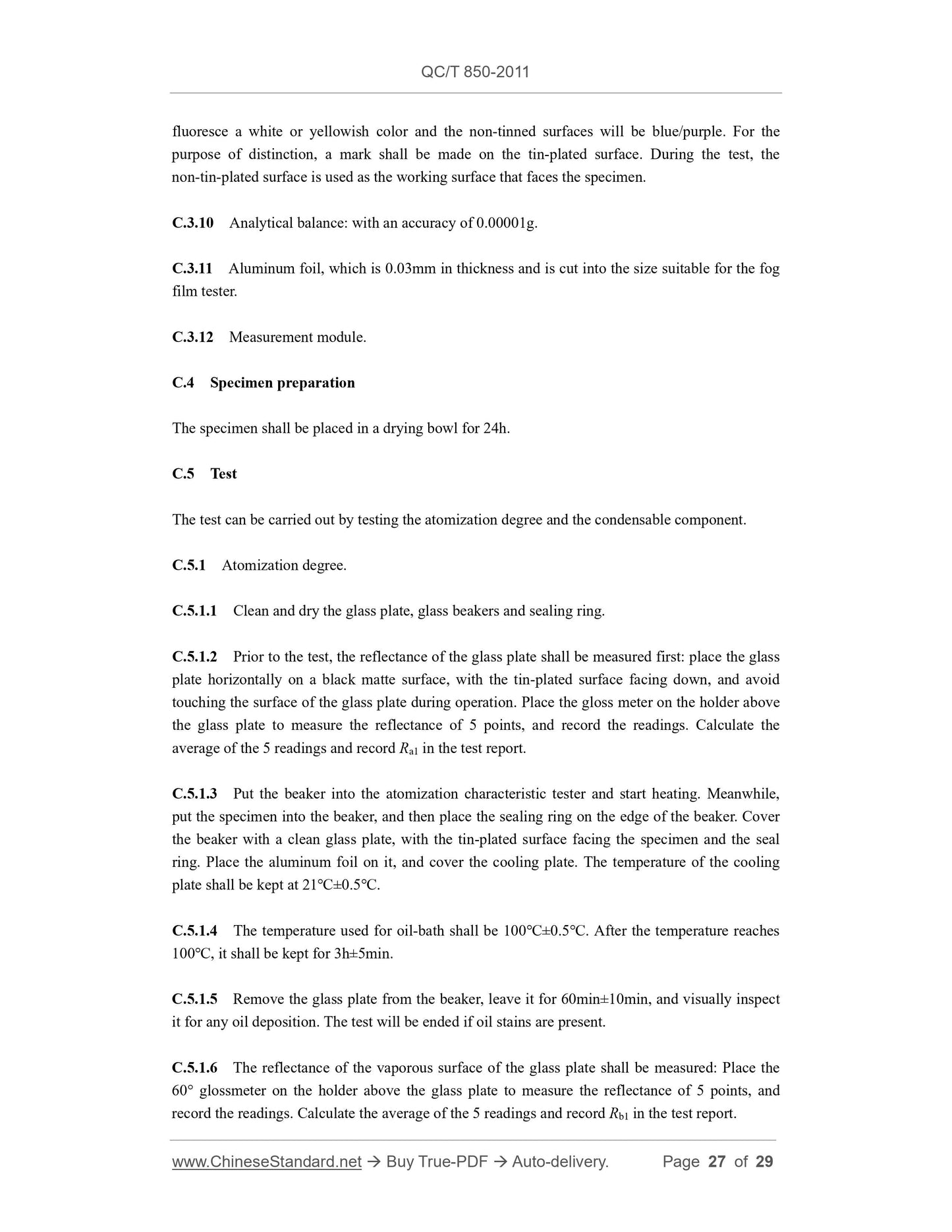1
/
의
12
PayPal, credit cards. Download editable-PDF and invoice in 1 second!
QC/T 850-2011 English PDF (QCT850-2011)
QC/T 850-2011 English PDF (QCT850-2011)
정가
$175.00 USD
정가
할인가
$175.00 USD
단가
/
단위
배송료는 결제 시 계산됩니다.
픽업 사용 가능 여부를 로드할 수 없습니다.
Delivery: 3 seconds. Download true-PDF + Invoice.
Get QUOTATION in 1-minute: Click QC/T 850-2011
Historical versions: QC/T 850-2011
Preview True-PDF (Reload/Scroll if blank)
QC/T 850-2011: Polyurethane foam for seating of passenger car
QC/T 850-2011
QC
AUTOMOBILE INDUSTRY STANDARD
OF THE PEOPLE’S REPUBLIC OF CHINA
ICS 43.040.60
T 26
Polyurethane foam for seating of passenger car
ISSUED ON: MAY 18, 2011
IMPLEMENTED ON: AUGUST 01, 2011
Issued by: Ministry of Industry and Information Technology of PRC
Table of Contents
Announcement ... 3
Foreword ... 6
1 Scope ... 7
2 Normative references ... 7
3 Terms and definitions ... 8
4 Grading ... 8
5 Requirements ... 8
6 Test methods ... 10
7 Inspection rules ... 14
8 Marking, packaging, transport and storage ... 15
Annex A (Normative) Test methods for emission performance of interior materials .. 16
Annex B (Normative) Test on odor of foam for seating of passenger car ... 23
Annex C (Normative) Test method for fogging characteristics of foam material for
seating of passenger car ... 26
Polyurethane foam for seating of passenger car
1 Scope
This standard specifies the grading, requirements, test methods, inspection rules as well as
marking, packaging, transport and storage of cushions and backrests made from polyurethane
foam for foamed seating (with fixed shape) of passenger car.
This standard is applicable to polyurethane foam used as antishock and comfort cushion materials
for making cushions and backrests of seating of passenger car.
2 Normative references
The following referenced documents are indispensable for the application of this document. For
dated references, only the edition cited applies. For undated references, the latest edition of the
referenced document (including any amendments) applies.
GB/T 2918-1998 Plastics - Standard atmospheres for conditioning and testing (ISO 291:
1997, IDT)
GB/T 3730.1-2001 Motor vehicles and trailers - Types - Terms and definitions
GB/T 6343-2009 Cellular plastics and rubbers - Determination of apparent density (ISO
845: 2006, IDT)
GB/T 6344-2008 Flexible cellular polymeric materials - Determination of tensile strength
and elongation at break (ISO 1798: 2008, IDT)
GB/T 6669-2008 Flexible cellular polymeric materials - Determination of compression set
(ISO 1856: 2000, IDT)
GB/T 6670-2008 Flexible cellular polymeric materials - Determination of resilience by ball
rebound (ISO 8307: 2007, MOD)
GB 8410-2006 Flammability of automotive interior materials
GB/T 9640-2008 Flexible and rigid cellular polymeric materials - Accelerated ageing tests
(ISO 2440: 1997, IDT)
GB/T 10807-2006 Flexible cellular polymeric materials - Determination of hardness
(indentation technique) (ISO 2439: 1997, IDT)
GB/T 10808-2006 Flexible cellular polymeric materials - Determination of tear strength (ISO
8067: 1989, IDT)
GB/T 18941-2003 Flexible cellular polymeric materials - Determination of fatigue by
constant-load pounding (ISO 3385: 1989, IDT)
GB/T 18942.1-2003 Flexible cellular polymeric materials - Determination of stress-strain
characteristics in compression - Part 1: Low-density materials (ISO
3386-1: 1996, IDT)
5.1.1 The foam parts for seating must be fully extruded by roller, press, vacuum or some
extrusion method on the production line to break the original cellular structure and ensure the
compression characteristics and hand feeling of the holes, minimize the initial loss of bearing
thickness during fatigue and ensure the dimensional stability of the whole part.
5.1.2 The adhesive strength of the material placed in the foaming mould and forming an integral
part of the foam part during foaming shall be greater than that of the foam.
5.1.3 The adhesive used shall be the one that does no damage to the foam, and the bonding
effect shall be at least as good as the foam itself. The adhesion between foams shall meet the
requirements of flammability specified in GB 8410-2006. The adhesive must also meet the odor
requirements.
5.1.4 Operate in accordance with normal production inspection and quality procedures. The
product shall be allowed to be repaired with the foam for repair or correction having the same
component and quality as the initial product. The foam for correction shall have no adverse effect
on the performance and the amount of dimension and shape changed not exceed the given
tolerance range.
5.1.5 There shall be no loose pellicle on the recognized important surface.
5.1.6 Polyurethane foam products shall meet the durability test requirements of the seating
assembly and, after the durability test of the seating assembly, the foam parts shall not adversely
affect the structure and appearance of the cover.
5.1.7 For the purposes of this standard, the materials limited by laws and regulations apply.
5.1.8 The product shall not irritate the skin after being completely solidified.
5.1.9 All products must bear identification such as part number, supply source and production
date. The identification must be positioned in such a way that it does not affect the appearance of
the finished product (at the lower surface of the cushion and the rear surface of the backrest) and
must be legible and distinguishable. The letter height shall be indicated on the product drawing.
5.2 Physical property requirements
Table 2 lists the property requirements of four grades of polyurethane foam for seating of
passenger car.
6.1.2 All test samples shall be placed under natural conditions for 72h after production. Before
the test, the samples shall be conditioned under standard test conditions for 16h, which shall be
free from deformation and distortion.
6.1.2 All specimens shall be cut from the indentation stress zone of the cushion and backrest of
the foam sample for seating of passenger car.
6.1.4 All foam samples shall be pre-pressurized twice to 70%~80% of their thickness before
conditioning or testing.
6.1.5 For each test, there shall be not less than 3 specimens. The arithmetic mean from 3 tests
shall be recorded. The test results of each specimen shall meet the required values set forth in this
standard.
6.2 Fatigue performance by constant-load pounding
It shall be tested in accordance with GB/T 18941-2003. Under a constant load of 750N, 80,000
times of uninterrupted pressure cycles shall be carried out to carry out the constant load impact
fatigue test.
6.3 Indentation hardness
6.3.1 The Method A in GB/T 10807-2006, 7.2 shall be used for testing the indentation hardness.
Unless otherwise specified on the part drawing, the indentation hardness shall be tested on the
whole specimen.
a) In the indentation hardness test, the indenter shall be operated at a constant speed of (100±20)
mm/min;
b) Measure the initial thickness under a contact force of 5
1 N after prepressing;
c) On the long foam parts for rear seating, the measured indentation hardness values at the left
and right measuring points shall not change by more than 10%.
6.3.2 The sample used for indentation hardness test shall be supported by a rigid support plate
which shall fully fill the obvious depressions on the foam bottom surface (Surface B). The test
surface of the foam supported by the support plate shall be parallel to the tester base in horizontal
position. The minimum size of the rigid support plate used for support shall be 380 mm× 380 mm.
The testing position of indentation hardness shall be marked on the part drawing and the upper
surface of foam sample.
6.4 Combustion performance
6.20 Compression deformation after damp heat ageing (50%)
The damp heat ageing test shall be carried out in accordance with GB/T 9640-2008, 7.2, with a
test temperature of 105℃ and a relative ...
Get QUOTATION in 1-minute: Click QC/T 850-2011
Historical versions: QC/T 850-2011
Preview True-PDF (Reload/Scroll if blank)
QC/T 850-2011: Polyurethane foam for seating of passenger car
QC/T 850-2011
QC
AUTOMOBILE INDUSTRY STANDARD
OF THE PEOPLE’S REPUBLIC OF CHINA
ICS 43.040.60
T 26
Polyurethane foam for seating of passenger car
ISSUED ON: MAY 18, 2011
IMPLEMENTED ON: AUGUST 01, 2011
Issued by: Ministry of Industry and Information Technology of PRC
Table of Contents
Announcement ... 3
Foreword ... 6
1 Scope ... 7
2 Normative references ... 7
3 Terms and definitions ... 8
4 Grading ... 8
5 Requirements ... 8
6 Test methods ... 10
7 Inspection rules ... 14
8 Marking, packaging, transport and storage ... 15
Annex A (Normative) Test methods for emission performance of interior materials .. 16
Annex B (Normative) Test on odor of foam for seating of passenger car ... 23
Annex C (Normative) Test method for fogging characteristics of foam material for
seating of passenger car ... 26
Polyurethane foam for seating of passenger car
1 Scope
This standard specifies the grading, requirements, test methods, inspection rules as well as
marking, packaging, transport and storage of cushions and backrests made from polyurethane
foam for foamed seating (with fixed shape) of passenger car.
This standard is applicable to polyurethane foam used as antishock and comfort cushion materials
for making cushions and backrests of seating of passenger car.
2 Normative references
The following referenced documents are indispensable for the application of this document. For
dated references, only the edition cited applies. For undated references, the latest edition of the
referenced document (including any amendments) applies.
GB/T 2918-1998 Plastics - Standard atmospheres for conditioning and testing (ISO 291:
1997, IDT)
GB/T 3730.1-2001 Motor vehicles and trailers - Types - Terms and definitions
GB/T 6343-2009 Cellular plastics and rubbers - Determination of apparent density (ISO
845: 2006, IDT)
GB/T 6344-2008 Flexible cellular polymeric materials - Determination of tensile strength
and elongation at break (ISO 1798: 2008, IDT)
GB/T 6669-2008 Flexible cellular polymeric materials - Determination of compression set
(ISO 1856: 2000, IDT)
GB/T 6670-2008 Flexible cellular polymeric materials - Determination of resilience by ball
rebound (ISO 8307: 2007, MOD)
GB 8410-2006 Flammability of automotive interior materials
GB/T 9640-2008 Flexible and rigid cellular polymeric materials - Accelerated ageing tests
(ISO 2440: 1997, IDT)
GB/T 10807-2006 Flexible cellular polymeric materials - Determination of hardness
(indentation technique) (ISO 2439: 1997, IDT)
GB/T 10808-2006 Flexible cellular polymeric materials - Determination of tear strength (ISO
8067: 1989, IDT)
GB/T 18941-2003 Flexible cellular polymeric materials - Determination of fatigue by
constant-load pounding (ISO 3385: 1989, IDT)
GB/T 18942.1-2003 Flexible cellular polymeric materials - Determination of stress-strain
characteristics in compression - Part 1: Low-density materials (ISO
3386-1: 1996, IDT)
5.1.1 The foam parts for seating must be fully extruded by roller, press, vacuum or some
extrusion method on the production line to break the original cellular structure and ensure the
compression characteristics and hand feeling of the holes, minimize the initial loss of bearing
thickness during fatigue and ensure the dimensional stability of the whole part.
5.1.2 The adhesive strength of the material placed in the foaming mould and forming an integral
part of the foam part during foaming shall be greater than that of the foam.
5.1.3 The adhesive used shall be the one that does no damage to the foam, and the bonding
effect shall be at least as good as the foam itself. The adhesion between foams shall meet the
requirements of flammability specified in GB 8410-2006. The adhesive must also meet the odor
requirements.
5.1.4 Operate in accordance with normal production inspection and quality procedures. The
product shall be allowed to be repaired with the foam for repair or correction having the same
component and quality as the initial product. The foam for correction shall have no adverse effect
on the performance and the amount of dimension and shape changed not exceed the given
tolerance range.
5.1.5 There shall be no loose pellicle on the recognized important surface.
5.1.6 Polyurethane foam products shall meet the durability test requirements of the seating
assembly and, after the durability test of the seating assembly, the foam parts shall not adversely
affect the structure and appearance of the cover.
5.1.7 For the purposes of this standard, the materials limited by laws and regulations apply.
5.1.8 The product shall not irritate the skin after being completely solidified.
5.1.9 All products must bear identification such as part number, supply source and production
date. The identification must be positioned in such a way that it does not affect the appearance of
the finished product (at the lower surface of the cushion and the rear surface of the backrest) and
must be legible and distinguishable. The letter height shall be indicated on the product drawing.
5.2 Physical property requirements
Table 2 lists the property requirements of four grades of polyurethane foam for seating of
passenger car.
6.1.2 All test samples shall be placed under natural conditions for 72h after production. Before
the test, the samples shall be conditioned under standard test conditions for 16h, which shall be
free from deformation and distortion.
6.1.2 All specimens shall be cut from the indentation stress zone of the cushion and backrest of
the foam sample for seating of passenger car.
6.1.4 All foam samples shall be pre-pressurized twice to 70%~80% of their thickness before
conditioning or testing.
6.1.5 For each test, there shall be not less than 3 specimens. The arithmetic mean from 3 tests
shall be recorded. The test results of each specimen shall meet the required values set forth in this
standard.
6.2 Fatigue performance by constant-load pounding
It shall be tested in accordance with GB/T 18941-2003. Under a constant load of 750N, 80,000
times of uninterrupted pressure cycles shall be carried out to carry out the constant load impact
fatigue test.
6.3 Indentation hardness
6.3.1 The Method A in GB/T 10807-2006, 7.2 shall be used for testing the indentation hardness.
Unless otherwise specified on the part drawing, the indentation hardness shall be tested on the
whole specimen.
a) In the indentation hardness test, the indenter shall be operated at a constant speed of (100±20)
mm/min;
b) Measure the initial thickness under a contact force of 5
1 N after prepressing;
c) On the long foam parts for rear seating, the measured indentation hardness values at the left
and right measuring points shall not change by more than 10%.
6.3.2 The sample used for indentation hardness test shall be supported by a rigid support plate
which shall fully fill the obvious depressions on the foam bottom surface (Surface B). The test
surface of the foam supported by the support plate shall be parallel to the tester base in horizontal
position. The minimum size of the rigid support plate used for support shall be 380 mm× 380 mm.
The testing position of indentation hardness shall be marked on the part drawing and the upper
surface of foam sample.
6.4 Combustion performance
6.20 Compression deformation after damp heat ageing (50%)
The damp heat ageing test shall be carried out in accordance with GB/T 9640-2008, 7.2, with a
test temperature of 105℃ and a relative ...
Share
